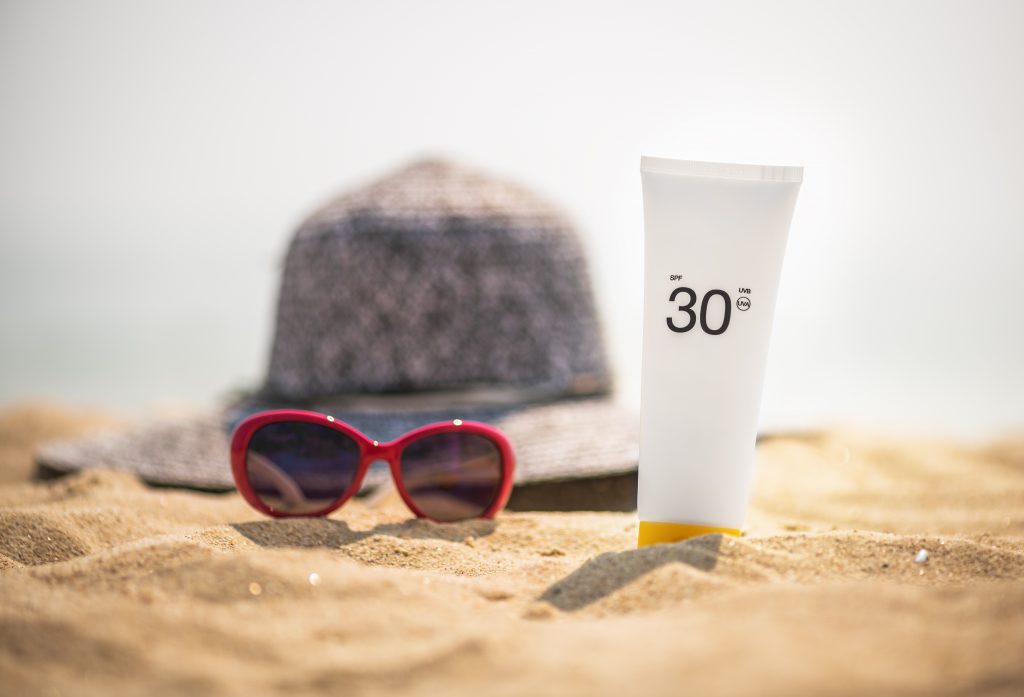Four Sunscreen Myths About Skincare

Sunscreen is taking center stage as we move from spring to summer. Using sunscreen can be incredibly effective in protecting from ultraviolet rays and is a must-have for every single person going outdoors or sitting near a window near the sun. According to the American Academy of Dermatology Association, one in five Americans will develop skin cancer in their lifetime. The sun, although beautiful, warm, and part of life over the next six months with spring breaks and summer vacations coming, should be taken seriously. In fact, if more people took the sun’s intensity more seriously, many skin cancer cases would never happen. Here, we look at four popular sunscreen myths just in time to clarify any confusion before the heat is on!
Please hear this! Safe tanning does not exist – every time you expose your skin to the sun, damage occurs.
1. I have Darker Skin, So I Don’t Need Sunscreen
Anyone is susceptible to skin cancer from exposure to the sun’s ultraviolet rays. Age doesn’t matter. Gender doesn’t matter. Race doesn’t matter. The sun is not biased, and everyone is at risk and should incorporate sunscreen into their daily routine. Many with olive or darker skin think they are less vulnerable to the sun’s rays. This is simply not true. Although someone with fairer skin may burn more easily or have more severe and apparent reactions to a burn, the same damage occurs on all skin types. If you have darker skin and do not like the heavy creams that do not blend, there are highly rated sunscreens for black skin that blend flawlessly. Your local dermatologist may also have a brand to recommend for your skin specifically. If you are sensitive to the typical heavier creams offered in sunscreens, do your research. There are many highly rated sunscreens for all skin types. Do not use skin color, gender, or age as an excuse not to use it.
2. Anything Over SPF30 Doesn’t Protect More
The American Academy of Dermatology suggests sunscreens of SPF30 or higher. There are greater SPF available, and they are stronger. However, the myth around SPF numbers is that a higher SPF offers longer protection. This is not the case, and all sunscreens must be re-applied during extended exposure to the sun. This means sporting events, mowing the lawn, going to the beach or park, and simply out for a walk.
No sunscreen can block 100% of the sun’s rays. For this reason, re-application and taking other measures are essential to protecting your skin. Wearing hats, sunglasses, lip sunscreen and even lightweight clothes ensure you are doing everything you can to protect your skin and reduce your likelihood of getting skin cancer from the sun.
3. Sunscreen Prevents Me from Getting Vitamin D
The sun does indeed provide vitamin D. However, most people can get the amount they need from the foods they eat or vitamin supplements. If you are concerned about the amount of vitamin D you are getting, it is essential to ask your doctor. Doctors can test your blood for vitamin D levels and recommend supplements or prescription doses. It is wise not to rely on the sun’s dangerous ultraviolet rays to get your body all the vitamin D it needs. Finding an alternative way to get your vitamin D can significantly decrease your risk of getting skin cancer and keep skin healthy.
4. If It Is Cloudy, You Don’t Need Sunscreen
This is by far one of the most dangerous myths out there. When it is cloudy, many people do not even think about putting sunscreen on or that their skin is being exposed to UV rays. Even on cloudy and cooler days, the sun never stops emitting UV light, which can go right through clouds and onto your skin. More than 90% of UV rays can pass through clouds.
There are two types of rays that your skin needs protection from. Overexposure to UVA and UVB rays is a contributor to skin cancer. The UVA rays cause wrinkles age spots and can go through windows or glass. UVB rays are the primary reason skin burns, and these rays are blocked by glass. Although this is good information to know, instead of guessing which rays are going through what materials, focus on starting a regular sunscreen routine.
Sunscreens are also recommended to be water-resistant since many outdoor activities include being in and around the water and the body’s natural coolant system of sweating. Sunscreens, used correctly, can protect from 97% of UVA and UVB rays.
Everyday Sun Care
Although a powerful tool against the sun’s intensity, sunscreen must be a part of a lifestyle. It is recommended to find shade when possible, especially between 10-2 when the rays are most intense. Wearing long-sleeved and lightweight attire allows extra protection, as well as hats and sunglasses to protect the eyes. Avoid all tanning in beds. Getting an even tan is the desire of many people, but there are many cosmetic self-tanning lotions and oils that give a tan or smooth appearance but do not expose your skin to dangerous UV rays.
Be aware of your skin, and if any changes appear on your skin or you experience itching or bleeding, see a dermatologist immediately. Skin cancer, if caught early, can be successfully treated. Professional dermatologists like Dr. Sherrie Straughn have experience treating different skin types and will offer skin cancer screenings.
